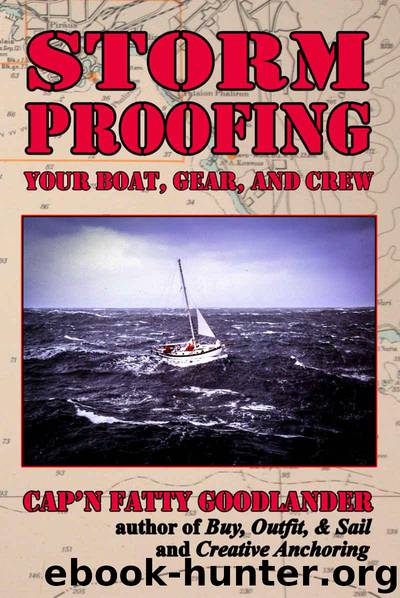Storm Proofing your Boat, Gear, and Crew by Goodlander Cap'n Fatty

Author:Goodlander, Cap'n Fatty [Goodlander, Cap'n Fatty]
Language: eng
Format: azw3
Published: 2016-05-26T16:00:00+00:00
You are done. If you buy all this stuff used or trade or beg for it—it will cost you almost nothing. Note: This method will allow water to leak into your anchor locker—which probably has a self-draining hole in it anyway. If you want to do this above your forecastle bunk, you’ll need to add two more pad eyes to the mix or put a chainplate on the forward bulkhead if you deem it strong enough. But be aware it could leak on your bunk.
The point I’m trying to make is that sailors used to do stuff like this all the time. In my day, very few people could afford a yacht rigger.
How to tell what plates, bolts, wire size, turnbuckle, and clevis pin to use? Easy. Let’s say you have a 34-foot boat. Go to the shipyard spar shed and examine the masts of well-built boats in the 36- to 38-foot range. Duplicate!
The roller furling inner forestays of Ganesh, Wild Card, and Carlotta cost me about $50 to $100 out-of-pocket. The gears were “dumpster-dove” rather than purchased, and all three functioned perfectly for many years and many ocean crossings.
Do I recommend that every cruising boat have a staysail? No, I do not. A staysail is not necessary. It is a luxury. But it is luxury worth considering on a dedicated offshore vessel and mandatory on a storm-strutter. Even more important is for you to understand the trade-offs of such a DIY project, because everything on a boat is a trade-off.
I want my readers—especially my empty-pocketed readers—to realize that, hey, the poor sap with the three-year-old Hylas 47 might be constrained by its resale value and not feel that he could justify the $10,000 his rigger estimates that adding a staysail would cost. But a penniless sea gypsy on a beat-up Westsail 32 isn’t nearly so limited. He can quickly do the job himself for a hundred bucks or so and end up with a better, safer vessel—for the simple reason he’s not a victim of his wallet.
A young fit couple can have a blast in the Caribbean aboard a double-ended Pacific Seacraft 28—or a miserable time trying to maintain a too-big, too-fancy, too-bullshit Oyster 56.
I repeat—there is no reason that a 30-year-old trashed-out cruising boat shouldn’t be far safer at sea than a brand-new one with a stick-on keel. All it requires, really, is an owner who is willing to learn seamanship and pay in sweat equity.
Download
This site does not store any files on its server. We only index and link to content provided by other sites. Please contact the content providers to delete copyright contents if any and email us, we'll remove relevant links or contents immediately.
Breath by James Nestor;(2163)
The River by Peter Heller(2153)
Deep by James Nestor(2087)
Fatal Storm by Rob Mundle(2084)
Sea Survival Handbook by Keith Colwell(2045)
Lonely Planet Australia by Lonely Planet(1974)
Iced In by Chris Turney(1853)
Discover Australia by Lonely Planet(1845)
Lonely Planet Maldives (Travel Guide) by Planet Lonely & Masters Tom(1736)
One Girl One Dream by Dekker Laura(1582)
Looking for a Ship by John McPhee(1577)
Ten Degrees of Reckoning: The True Story of a Family's Love and the Will to Survive by Hester Rumberg(1554)
Chicken Soup for the Ocean Lover's Soul by Jack Canfield(1553)
Lonely Planet Australia (Travel Guide) by Lonely Planet & Lonely Planet(1512)
South with the Sun by Lynne Cox(1463)
The Wave In Pursuit of the Rogues, Freaks and Giants of the Ocean(1431)
Diver Down by Michael Ange(1423)
Marlinspike Sailor's Arts and Crafts by Barbara Merry(1412)
The Golden Rules: 10 Steps to World-Class Excellence in Your Life and Work by Bob Bowman & Charles Butler(1386)
